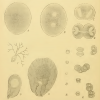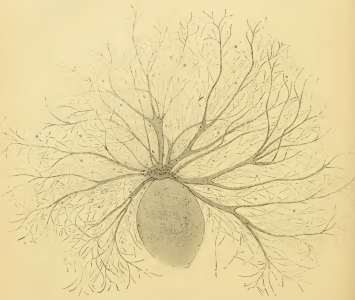Amyloodinium amylaceum
Diagnosis
Diagnosis_Genus: Amyloodinium Brown & Hovasse 1946. Ectoparasites on gills but also on the rest of the surface of most various species of marine fishes. The trophont has an attachment disc with a very short peduncle, the circumference of the disc radiates into long filiform projections embedded deeply into the epithelial cells of the host. A special tentacle-like movable organ, stomopode, extends along with the peduncle of the attachment disc from the basal end of the cell: its function may by food ingestion and/or injection of lytic bodies into the host cells. No chloroplast. Thecal alveoli with plates. Cytoplasm contains large digestive vacuoles with particulate food, starch grains, splindle-shaped bodies, clove-like bodies and lytic bodies and subthecally located mucocysts and acontobolocysts. Size of trophont does not exceed 150 µm. Division of the palmella (tomont) stage takes place within a common cyst wall; up to 256 gymnospores produced. Gymnospore with stigma (eye spot).
Diagnosis_Species: Oodinium amylaceum Bargoni 1894. Ectoparasite of Sarpa salpa (gills). Mature trophont from yellow to yellow-brown. Well developped fixative apparatus, supported by a short peduncule and important rhizoidal ramifications inside the host tissue. These internal ramifications may be as long as the trophont outside its host. Sporogenesis incompletely observed. Eye spot not observed.
Pigment: No
Etymology
The species name refers to the granules that were interpretated by Bergoni as starchs (amidon).
Type species
The type species for the genus is Amyloodinium ocellatum.
Type illustration / Type locality / Type specimen
Type Host: Sarpa salpa
Type locality: Naples, Messine harbour.
Type illustration: Bargoni 1894, pl.III & IV
Ecology
Substrate: epizoic
Sociability_trophont: gregarious
Salinity: marine
Life cycle
Generation: <1 month
Reproduction_mode: asexual
Feeding behaviour
Reference(s)
Observation site(s)
HOSTS
| Association with... | Region origin | Name of site | In reference... |
|---|---|---|---|
| Sarpa salpa | Messine harbor | ||
| Sarpa salpa | Naples |
(1920) Les péridiniens parasites. Morphologie, Reproduction, Ethologie. . Archives de Zoologie Expérimentale et Générale 59:1-475. |
















